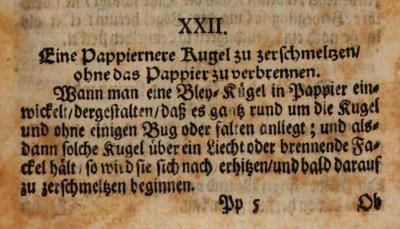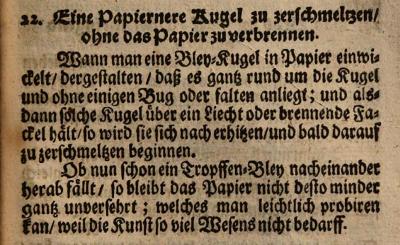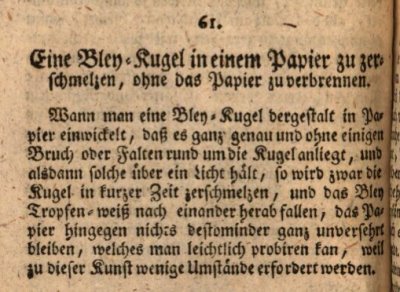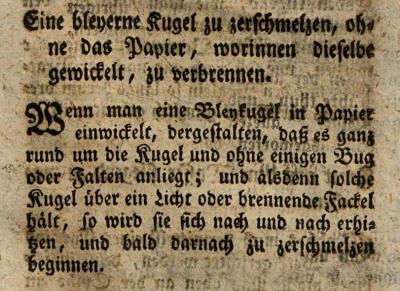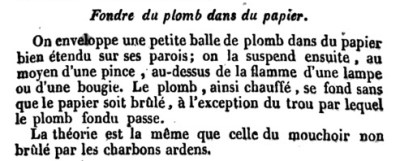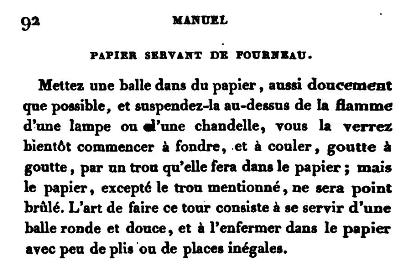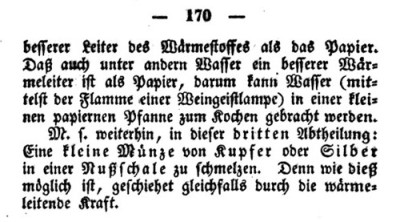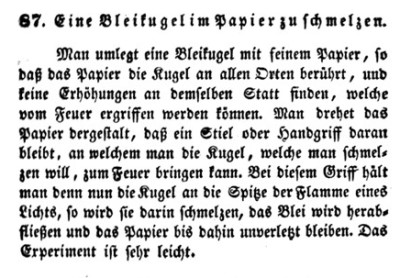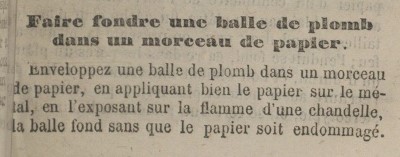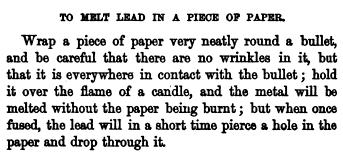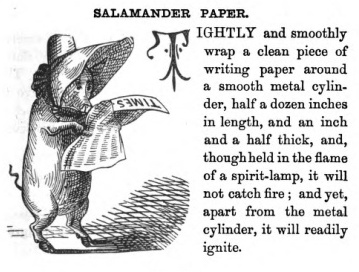| The Public Paperfolding History Project
Last updated 8/8/2023 x |
|||||||
| The Paper Furnace / How to Melt Lead in Paper | |||||||
| This
page is being used to collect information about the
history of the scientific effect known as The Paper
Furnace in which a ball of lead is melted inside a
wrapping of paper. Please contact me if you know any of
this information is incorrect or if you have any other
information that should be added. Thank you. ********** 1702 As far as I know a description of this effect first appears in 'Neueröffnete Raritäten und Kunst-Kammer' by Simon Witgeest, which was published in Nurnberg in 1702.
********** The effect also appears: 1707 In 'Natürliches Zauber-Buch oder neuer Spiel-Platz der Kunste' by Simon Witgeest, which was published in 1707.
********** 1762 In part two of 'Die Zehenmal Hundert und Eine Kunst' by Albrecht Ernst Friedrich von Crailsheim, which was published in 1762.
********** 1785 In 'Künste und Geheimnisse von Philadelphia zur Belastigung Jedermanns', which was published in Amsterdam in 1785.
********** 1813 In 'Die Zauberkunst' by Carl Ferdinand Leischner, which was published in Ilmenau, Thuringia, in 1831.
********** 1828 In 'The Boy's Own Book' by William Clarke, which was published by Vizetelly, Branston and Company in London in 1828.
********** 1829 In 'Manuel Complet des Sorciers' by M Comte, which was first published in 1829.
********** 1831 As 'Papier Servant du Forneau' in Volume 2 of 'Manuel des Jeunes Gens', which was published in Paris by Librairie Encyclopedique de Roret in Paris in 1931.
********** In 'Mechanemata oder der Tausendkünstler' by Dr Heinrich Rockstroh, which was published in 1831.
********** 1839 In the 5th edition of 'Das Buch der Zauberei' by Johann August Donndorff, which was published in Vienna in 1839.
********** 1844 In 'The Boy's Treasury of Sports, Pastimes and Recreations' by Samuel Williams, which was published by D Bogue in London in 1844.
********** 1863 In 'Spielbuch fur Knaben' by Hermann Wagner, which was published by Verlag von Otto Spamer in Leipzig in 1864 (although the foreword is dated May 1863, which argues that the book was complete at that date).
********** 1861 In 'Le Parfait Magicien le Plus Complet', which was published by Le Bailly, Libraire in Paris in 1861.
********** 1864 In 'Every Little Boy's Book', which was published by Routledge, Warne and Routledge in London and New York in 1864.
********** 1872 A similar effect, although in this case the metal is not lead and so does not therefore melt, can be found in 'Hanky Panky', a book of magical effects, puzzles, recreational mathematics and other amusements, by W H Cremer, Jun, was published by John Camden Hotten in London in 1872. (I believe that the same effect also occurs in Cremer's earlier work 'The Secret Out' which was first published in the USA by Dick and Fitzgerald in 1859.)
********** |
|||||||
